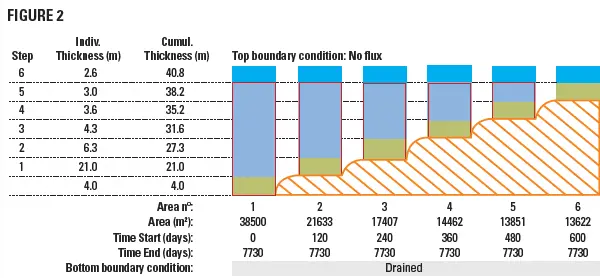Seepage modelling for a TSF is typically performed to predict seepage into the groundwater system, which is then used to determine the need for geosynthetic liners. An automated computing tool using Hydrus-1D and Python was developed to model seepage through an entire TSF. The model enables pseudo- 3D seepage modelling of the TSF that predicts seepage over time.
The seepage modelling portion of this tool is performed with Hydrus-1D, an industry standard one-dimensional time-dependent code that can simulate water and solute transport in a variably saturated porous medium. The coupling enables the computing tool to accommodate all tailings types. It can also use climatic data according to the site conditions and will model foundation conditions. The TSF is first discretised over time using the mill production and the topography (TSF storage curve). Each discretised block is modelled sequentially based on the rate of rise for each individual block. The outflow from each block is then summed to generate a curve to show the seepage variation as a function of time. The timescale can extend beyond the life of mine to include post-closure. The modelling tools can also accommodate geochemical processes and contaminant transport.
The programming uses Python with basic libraries. The Python code reads the input data, discretises the TSF as sequential blocks, prepares the Hydrus input files, runs the Hydrus-1D simulations, and then processes the outputs. The input is provided via a text or Microsoft Excel® file that contains tailings properties, climate data, mill production and storage curve.
The discretisation and the stacking sequence assembled by the Python code and modelled by Hydrus-1D are illustrated in Figures 1 and 2. Figure 1 shows the evolution of a given block over six time steps and Figure 2 shows the state of six blocks at a given time. Visualisation of the output is achieved using either Python or other software with graphical capabilities.
Given the automatic capability of this computing tool, sensitivity analyses are easy to perform by varying conditions such as hydraulic conductivities, foundation thicknesses, deposition rate and climatic conditions. It can accommodate Monte Carlo or point estimated method analyses for assessing the variability of the seepage released by a TSF. The model has been used for several projects where the bottom seepage of the TSF was predicted over time over the duration of the life of mine or to post-closure. The modelling results were used to determine whether the overall seepage below the TSF was within acceptable limits or whether a liner was required.

